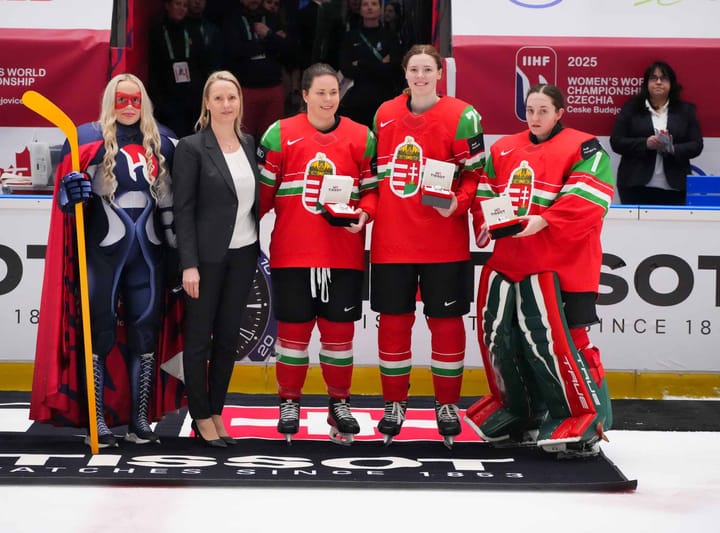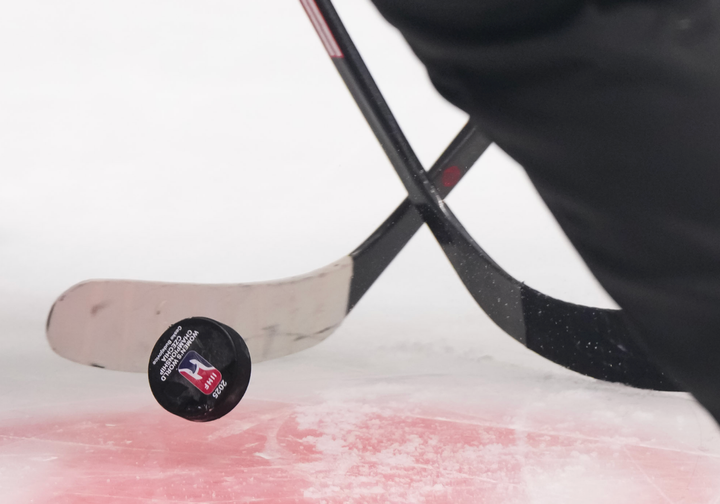Growing the Game in China: International Transfers and the Rules of Expansion
The CWHL is going to China, but are they free to take as many international players as they want?
The international transfer system gets significantly less media attention than other parts of the hockey bureaucracy, possibly because it is the realm of rules and regulations where the interested parties come to gloat or despair. It’s not sexy, but it is important, and it affects each league differently.
For some leagues, the chain of command is simple. In the CWHL’s case, unwinding the jurisdictions and exactly who answers to who is a bit more complicated, and takes on new importance with the recent expansion into China.
The Transfer Basics
The Switzerland-based International Ice Hockey Federation (IIHF) stands unopposed as the governing authority of world ice hockey, with individual nations, known as “member associations,” abiding by IIHF rules as they preside over hockey in their country: national bodies like USA Hockey, Hockey Canada, etcetera.
The IIHF maintains a set of transfer regulations separate from both the Statutes & Bylaws and the Code of Conduct. Any player, regardless of their professional status (we’ll get to that) or their membership status with their home country’s association, has to apply for an International Transfer Card, as stated in the opening paragraph of the International Transfer Regulations:
"All players - Men or women - who wish to move from one country, irrespective of whether or not they are registered with the member national association of that country, to the member national association of another country to compete in a competition under the jurisdiction of the member national association which leads to a champion being named are required to apply for a transfer by means of the IIHF transfer card."
Transfer cards serve a dual purpose for the IIHF: in addition to a trackable means of regulation for globetrotting players, the associated fees provide revenue.
Transfer cards can be limited or unlimited. According to Article 3.1 of the International Transfer Regulations,
“a limited transfer restricts the player's playing rights to a specific club and for a specific duration.”
In other words, a limited transfer card is good only with one club, for the length of one contract. Unlimited transfer cards are far less common and involve a player transferring to a national Member association instead of a specific club.
The International Transfer Regulations features provisions governing transfers by professional ice hockey players. "Professional" is defined in the International Transfer Regulations as "an ice hockey player who is paid more for his ice hockey player activity than the expenses he directly incurs through playing ice hockey." This is a solely legal definition, not a reflection of talent or value.
Under that definition, the 2016-2017 CWHL players were not professionals. That might change once the league begins compensating players, but equipment costs and lost wages might still outweigh the compensation. As of now it's unknown how much equipment will be provided to the 2017-2018 teams, but a source told The Ice Garden that all seven teams will be treated equally.
Breaking Down The Command Chain
Hockey Canada is, as its name suggests, the ruling body of hockey in Canada. The federation has 13 Member bodies at the provincial level that govern hockey within their borders. Ontario is divided into three Members: the Ontario Hockey Federation (OHF), Hockey Eastern Ontario, and Hockey Northwestern Ontario Hockey North covers the Northwest Territories and Nunavut, and the other provinces have one Member each.
Each Member is bound to Hockey Canada’s authority, but they’re allowed certain discretions as outlined in the Members’ Rights section of Hockey Canada’s Articles & Bylaws. They classify non-professional teams based on age and ability; there is some variation from Member to Member but the core remains the same. The first part of a team’s classification represents their age, ranging from Initiation for very young children all the way through Junior with an age limit of 21, and Senior, with no age limit. The second part, A, AA, AAA, represent skill, with AAA at the most elite level.
The CWHL stipulates players be at least 20 years old in their Entry Draft Guidelines, although they do grant exceptions. Since their players are predominately over 21 years of age, that puts them at Senior age. The League’s championship, the Clarkson Cup, is considered a National Championship by Hockey Canada, meaning each of the CWHL’s seven teams compete for the highest title available. That ensures them to be Female Senior AAA teams.
The CWHL maintains a cordial relationship with Hockey Canada, but that relationship does not appear to be binding. Hockey Canada is not listed as a sponsor in the CWHL’s most recent Annual Report.
Conversely, the league is not listed as a partner, nor is it mentioned in Hockey Canada's most recent Annual Report as a partner, an affiliated organization or a hockey partner.
Nor are they listed as Partners in the 2016-2017 Articles & Bylaws. According to Article 12.1:
"Hockey Canada, through its Board, may grant Partner status to organizations that Hockey Canada has recognized as significant stakeholders in the game of hockey in Canada."
Article 12.2 lists the Partners, among them the NHL, the Canadian Hockey League, U SPORT (formerly known as Canadian Interuniversity Sport or CIS), Canadian Armed Forces, Canadian Amputee Hockey Committee, the NHLPA, and more. The CWHL is not present.
With so many Team Canada stars calling the league home during its 10-year lifespan, warm relations are mutually beneficial to both sides. The CWHL gets the prestige of some of the world’s best players and legitimacy by association, while Hockey Canada gets a place for their top female athletes to stay in shape and play during non-Olympic years. The symbiosis helps growth, exposure, and opportunity.
In addition to a friendly relationship with Hockey Canada, the CWHL is also on good terms with the Ontario Women’s Hockey Association (OWHA), the governing body of women’s hockey in Ontario where the CWHL is headquartered. With all the work the OWHA has done for women's hockey, membership in the organization gives the CWHL legitimacy and access to their resources. The league’s marquee events are highlighted in the OWHA’s 2016-2017 Annual Report:
With the Chinese additions, nearly half the league (thanks, math) will be outside of Hockey Canada's jurisdiction, by virtue of being outside Canadian borders. Bylaw B7 lays out the procedure for out-of-jurisdiction teams wishing to compete in National Championships like the Clarkson Cup:
A Team under the jurisdiction of one (1) Hockey Canada Branch may compete in a League which is under the sole jurisdiction of another Hockey Canada Branch provided they have first received permission from their own Branch to negotiate entry into a League under the jurisdiction of another Branch and provided also that both Branches agree. A Branch shall submit the appropriate documents to the Board of Directors on or before June 1 of each year, listing the Teams seeking permission to play in other jurisdictions, together with the written approval of the incoming Branch. Teams must receive the approval of the Board of Directors in order to compete under the jurisdiction of another Branch where competition leads to a Hockey Canada Regional or National Championship.
Each year the permissions for Inter-Branch competition are renewed, allowing the league to function as it currently does with the four Canadian teams. Bylaws B9 and B10 make provisions for the admittance of teams outside Canada and establish how those permissions must be obtained. This allows for the CWHL’s non-Canadian teams to join in league play and participate in the Clarkson Cup playoffs.
Prior to the 2017-2018 season, the Boston Blades were the only team outside Hockey Canada's jurisdiction. As a team playing on United States soil, that puts them under USA Hockey and their rules. Under that same principle, Kunlun Red Star and the Vanke Rays will be under the Chinese Ice Hockey Association (CIHA). The CWHL has not responded to The Ice Garden's request for confirmation about which international federation will be in charge of the Chinese teams.
If the CIHA is in charge, then Canadian regulations about the number of international players will not apply for Kunlun Red Star and the Vanke Rays. Is that fair to the league's other five teams? That's up to the CWHLPA to decide.
After a month, still more questions than answers re expansion incl. on league fairness and player stipend amounts. Excited to know more soon
— CWHLPA (@CWHL_PA) July 25, 2017
Regulations From Within
There's also the CWHL's own internal policies and guidelines to consider. The Ice Garden has seen the league's official 2015 policy regarding international players and can confirm the Import limit was capped at four per team. In that policy, an international player was defined as an individual without Canadian or American citizenship and without a green card or work visa. In addition, the CWHL commissioner was responsible for approving each player's International status.
That limit of four falls within Hockey Canada’s limit. Their specifications for Senior Female AAA teams like those in the CWHL are very clear in the Bylaws & Regulations:
“Teams will be permitted to register Imports only to the extent that the total number of such active Imports does not exceed, at any one time during the current Season, the numbers prescribed below:
iii) A Senior Female AAA Team - Six (6)
Whether the league is still using that same version of regulations or has since updated them since the 2015 season has not been confirmed.
What It All Means For The CWHL
While it's certainly not unusual or unheard of for leagues to update their rules to accommodate change and circumstances, the Chinese expansion and the money that comes with it are unprecedented for a league like the CWHL. Public perception about the expansion itself and, specifically, the Sports Ambassador position - and the perks that come with it - vary wildly.
That said, the perception that will matter most is that of the players, especially since the CWHLPA and the CWHL have recently been in meetings to discuss the upcoming season.
The @CWHL_PA has requested information from @TheCWHL in regards to the upcoming season and looks forward to meeting next week #growthegame
— CWHLPA (@CWHL_PA) June 29, 2017
After a month, still more questions than answers re expansion incl. on league fairness and player stipend amounts. Excited to know more soon
— CWHLPA (@CWHL_PA) July 25, 2017
Money and attention bring increased scrutiny, and the China expansion puts renewed focus on the myriad rules at play for the CWHL. The league is set to begin compensating players this year, with no word yet on what form that compensation will actually take for the five North American teams and whether or not it will elevate them to professional status under the IIHF’s definition.
Meanwhile, the non-Chinese Import players from Europe and North America are set to earn significant paychecks, with some estimates ranging as high as $110,000 a year:
That is THREE DIGITS. $110,000 per year is unheard of in women's hockey. Don't know yet if that's US or Canadian $$$. https://t.co/tbJigAc9fH
— Hannah Bevis (@Hannah_Bevis1) June 29, 2017
Even if the final number winds up being in the five figures as other estimates suggest, these are all but unreal sums of money for female hockey players.
The CWHL has spent a decade building legitimacy and goodwill among the entire Canadian hockey community, not just those connected to Hockey Canada. The changes that occur this year may have been one factor that led to players like Brampton’s Kaitlyn Tougas and Toronto’s Jenelle Kohanchuk to seek opportunities elsewhere:
Just spoke with J. Kohanchuk who is leaving CWHL for MODO. Called 2017-18 a "regrouping" year for league but may return down the road.
— Joe Pack (@JoePack) August 11, 2017
Balancing international regulations, keeping the Chinese executives and government happy, building two competitive squads that allow the Chinese national team players to develop without being overshadowed by their international counterparts...the league’s work is just beginning.
Is it worth it? Time and history will tell.
UPDATE: The CWHL has responded to comment about the number of international players allowed on the Chinese teams this year.
The #CWHL has confirmed that Kunlun Red Star and Vanke Rays will be limited to 6 international players per team 1/2
— Meredith Foster (@fosterwrites) August 16, 2017
2/2 with "international" defined as any non-Chinese player. #CWHL
— Meredith Foster (@fosterwrites) August 16, 2017





Comments ()